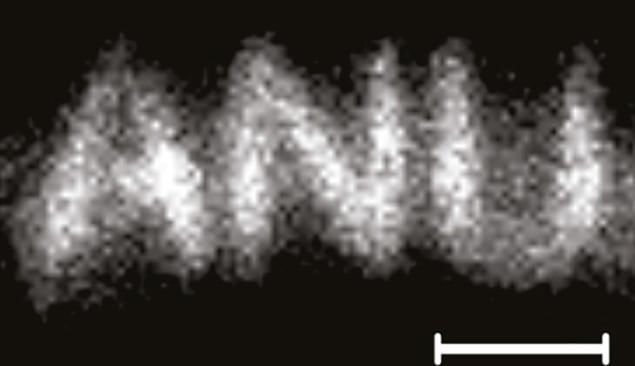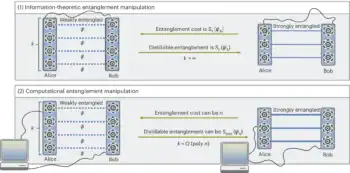
Ghost imaging – a counter-intuitive technique that produces images of an object using photons that have never interacted with it – has been performed for the first time using massive particles. The researchers believe that their new technique of ghost imaging using atoms instead of photons could be used to test fundamental principles of quantum mechanics.
The underlying concept of ghost imaging was first outlined by David Klyshko of Moscow State University in 1988. Pairs of correlated photons with equal and opposite momenta are sent simultaneously down different paths. The object of interest lies in the path of one photon from each pair. This photon may either interact with the object or pass directly to a detector, which records only the time of its arrival. The second photon travels an equal distance to a detector that precisely records both its arrival time and position.
If the photon travelling the first path does not interact with the object, each photon arrives at its detector at exactly the same time. If the first photon interacts with the object, however, it does not reach the detector or is delayed. Crucially, the second detector discards any photons that did not arrive at the same time as a photon hit the first detector. This allows it to build up a “ghost image” of the object in the first path. The technique was first demonstrated experimentally in 1995 by Alexander Sergienko – a former PhD student of Klyshko – and colleagues at the University of Maryland in Baltimore.
Intense atomic source
In principle, the set-up should work perfectly using massive particles such as atoms in place of photons. However, it had never previously been demonstrated because it is difficult to find a source of massive particle pairs that is intense enough to produce an image in a reasonable amount of time and yet has sufficiently precise correlations between particles that the detector can isolate the correlated ones. This is more difficult with massive particles because they travel much more slowly than photons, so the arrival times are less certain.
Now, physicists at the Australian National University in Canberra have solved this problem by splitting a Bose–Einstein condensate of ultracold helium atoms into 12 parts and then colliding the portions together. At each of the 11 collision points, a halo of pairs of scattered, correlated atoms is produced. The researchers allowed the diffracted atoms to fall under gravity, placing a mask in the path of some of the falling atoms and recording only the arrival time of atoms travelling this path. Other atoms had both position and arrival time recorded, and the team combined the information to produce a ghost image of the mask with submillimetre resolution.
Each halo of pairs was scattered with a slightly different momentum and therefore arrived at the detector at a different time, making it possible to correlate the atoms later. “This means that we can increase our data-acquisition rate by more than an order of magnitude,” says team member Sean Hodgman. Nevertheless, producing the image still required three weeks of imaging time.
Atom lithography
The researchers suggest that, with further development, the technique could potentially be used to allow atom lithography, for example, to be monitored and controlled in real time. Hodgman admits he is “sceptical as to whether it will ever actually have an application, but it’s possible”.
The technique could also prove useful for testing the fundamental principles of quantum mechanics with massive particles. In 2012, Anton Zeilinger and colleagues at the Institute for Quantum Optics and Quantum Information in Vienna, Austria, published a proposal to use ghost imaging to test whether or not separated entangled atoms exhibit non-local “Einstein–Podolsky–Rosen” (EPR) correlations between apparently localized properties such as momentum, so that a measurement of one can affect the state of the other. “Measuring EPR correlations with atoms has been a long-term goal of the field, and no one’s managed to come up with a practical scheme,” says Hodgman. Zeilinger’s test cannot be done using the team’s current apparatus but the researchers are working on alternative ways to perform it.
Sergienko, now of Boston University in Massachusetts, is impressed by the researchers’ achievements. “The major interesting feature here is the use of a massive particle,” he says. “To some extent, it’s much more difficult and complex than with photons – maybe that’s the reason people haven’t done it before. These people were able to overcome all the problems and make it work.”
The research is described in Nature.



